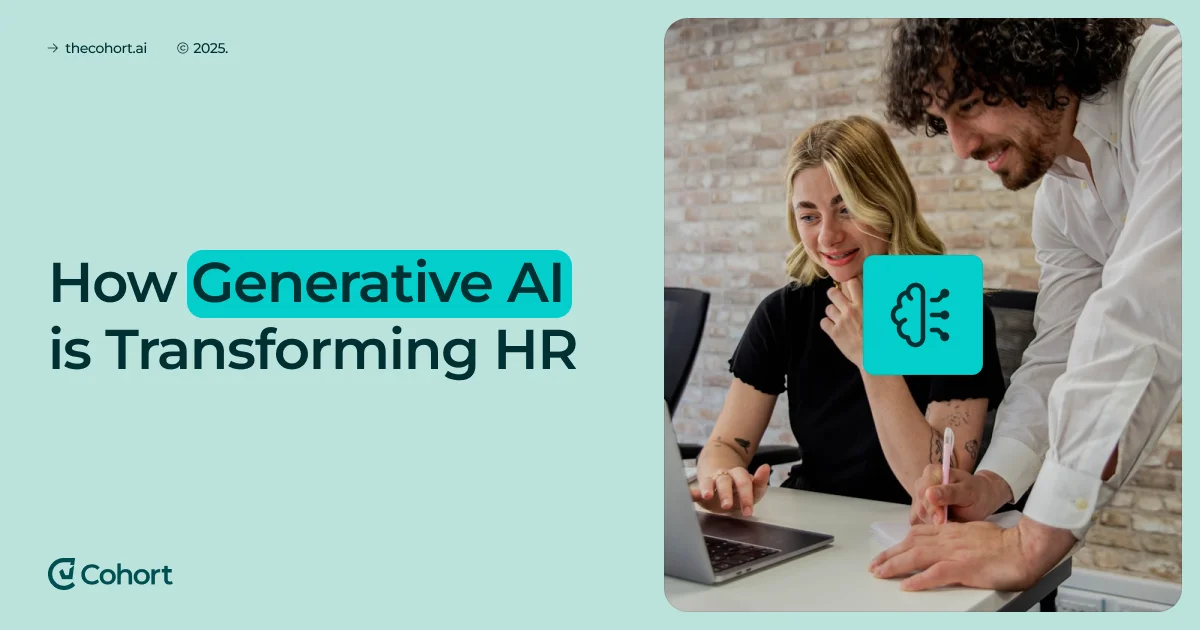If you're dealing with too many applicants and too little time, or struggling to scale your HR processes, you're not alone.
In fact, 91% of business leaders now recognize that generative AI is essential in HR.
In this article, you’ll learn how generative AI in HR is reshaping the way teams hire, support, and develop talent across the entire employee journey.
So, let’s start!
What is generative AI in HR?
Generative AI (GenAI) uses advanced machine learning to create content like text, summaries, or code by learning patterns from large datasets.
In HR, it’s being used not just to analyze information, but to generate original outputs that support daily operations and strategic initiatives.
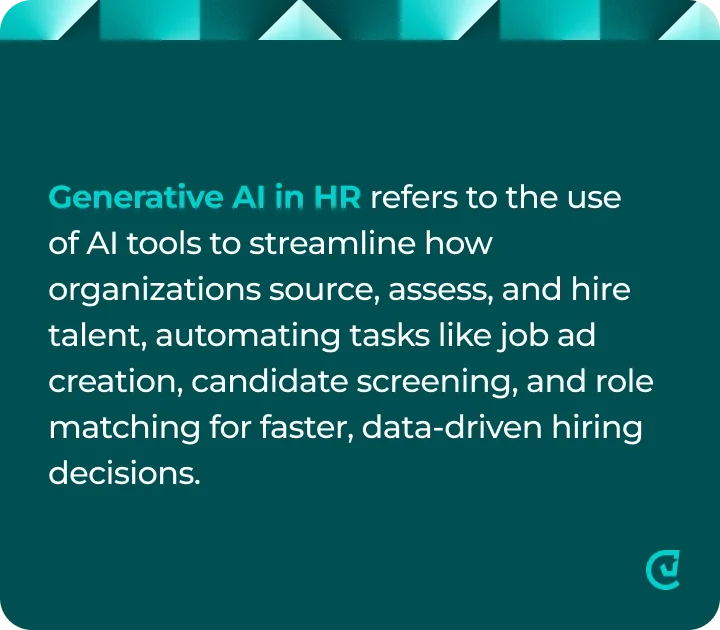
This allows HR teams to move faster, personalize at scale, and focus more on people instead of paperwork.
Why 2025 is the right time to use AI tools in hiring?
After the release of powerful language models in 2023 and 2024, many companies are moving from testing to real-world use, making generative AI a practical tool for HR teams.
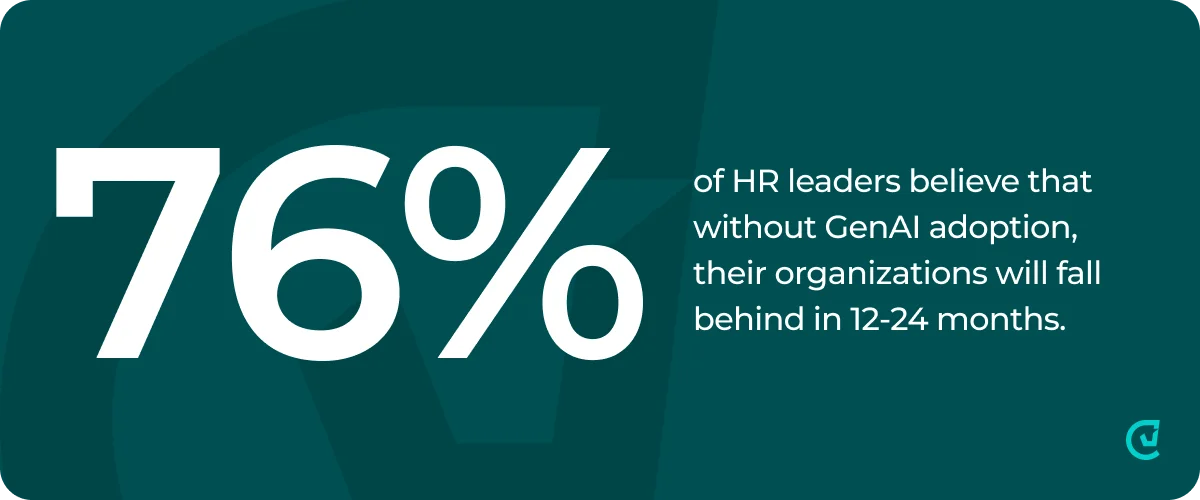
Instead of just exploring what's possible, they’re now planning how to use AI at scale.
That’s why 2025 is the year HR teams need to act by using AI to meet growing demands with fewer resources.
🚀 Here’s why 2025 matters:
- Rising urgency: 76% of HR leaders say that not adopting AI in the next 12-18 months could put their organization at a disadvantage.
- AI adoption is growing rapidly: Approximately 66% of HR teams currently utilize generative AI in some capacity. However, with workloads rising, budgets shrinking, and fewer staff, HR is projected to face a 12% productivity gap by 2025.
- New compliance risks: 81% of large employers are concerned about data protection laws and regulations on automated hiring. States like Illinois, Maryland, and New York City have already introduced restrictions.
How is generative AI used in HR hiring?
Generative AI is helping HR teams manage growing applicant volumes and streamline complex hiring workflows.
It assists throughout the hiring process, from screening to communication, so teams can focus on better decisions.
HR hiring automation with GenAI can:
- Identify top candidates: Analyzes resumes, public data, and behavioral signals to surface high-potential applicants aligned with the role and company culture.
- Write job ads and descriptions: Generates engaging, inclusive job posts based on prompts, brand tone, and specific role requirements.
- Automate admin tasks: Handles repetitive work like scheduling interviews, generating screening summaries, and preparing offer letters.
- Personalize candidate communication: Creates tailored outreach, reminders, and onboarding content so candidates feel seen, not spammed.
- Summarize feedback: Synthesizes interview notes and team comments into clear, structured summaries to speed up hiring decisions.
Now let’s look at what HR productivity tools can actually do to improve daily work and long-term outcomes.
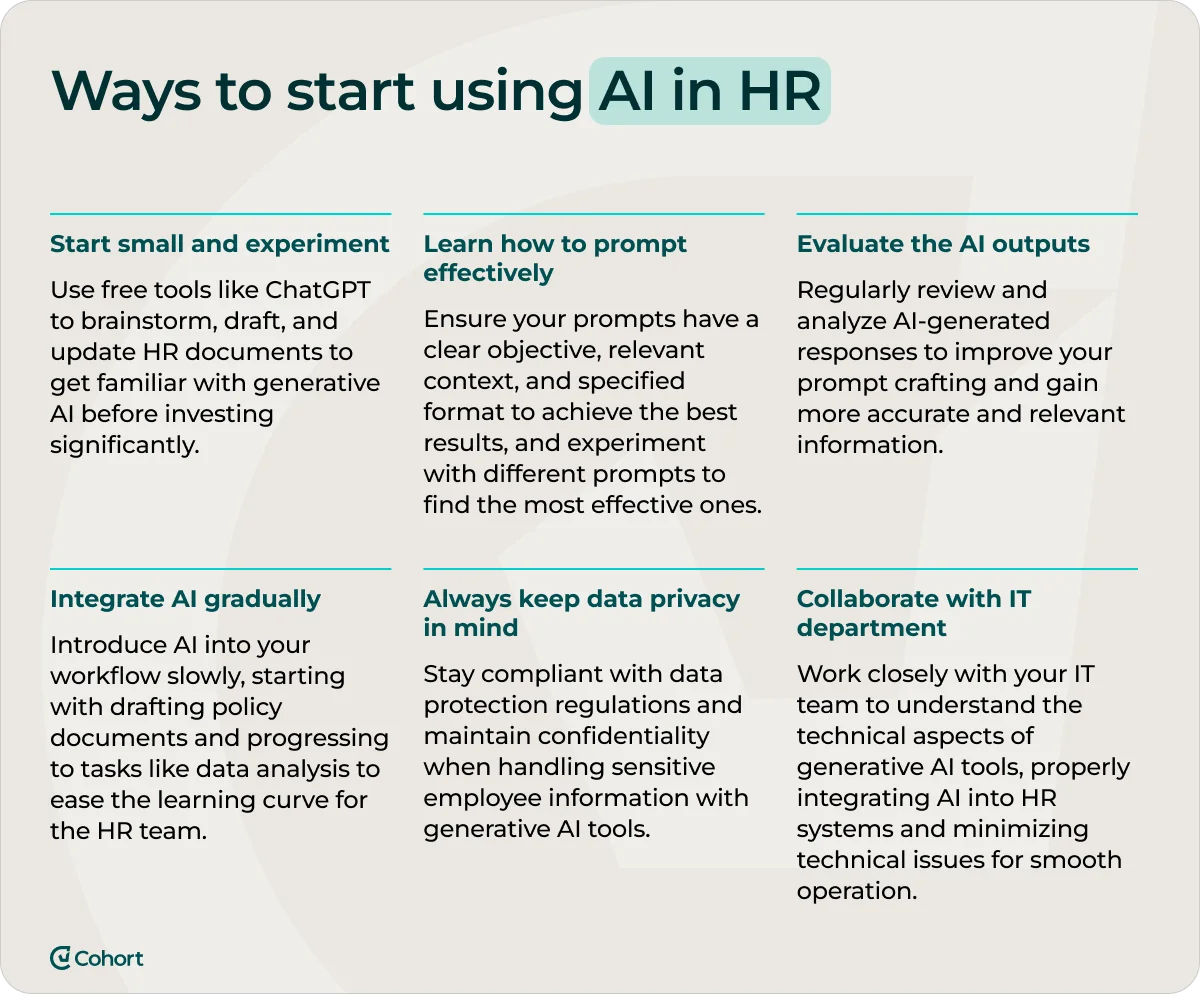
1. AI-driven sourcing and screening
AI is changing how recruiters find and evaluate candidates.
For example, today’s AI tools for recruiters can scan millions of profiles and resumes, identify potential matches, and rank them, often before a human gets involved.
Research indicates that approximately 40% of job applications are automatically filtered by AI systems before being reviewed by a recruiter.
🚀 Here’s how GenAI supports sourcing and screening:
- Resume and profile scanning: AI evaluates skills, experience, and other indicators at scale to quickly surface top candidates.
- Outreach automation: GenAI-powered tools generate personalized messages to engage passive candidates.
- Ad and message writing: AI drafts job ads and candidate emails, saving recruiters from repetitive writing tasks.
Many teams input company values and job requirements into GenAI systems to generate tailored emails or interview invites.
The recruiter can then review and refine the output.
💡 Pro tip
Cohort AI helps you build a fairer hiring funnel from the start by using agents like Sally the Scout to surface high-signal candidates based on skills.

Additionally, the talent graph and shortlisting system ensure better matches, consistent rankings, and DEI-aligned decisions.
Result? You get a ranked shortlist of the top 3 candidates, ready for review.
2. Automated and personalized job descriptions
GenAI enables faster and more effective writing of job descriptions.
HR teams can feed in role details or existing company content, and the AI will generate a targeted draft to attract qualified candidates.
🧠 Key stats and benefits:
- 65% of HR teams now use AI to help write job descriptions.
- AI-written, personalized outreach doubles candidate engagement rates, according to BCG.
- The same research claims that GenAI can draft content up to three times faster than a human.
✅ Additional note: Recruiters often use A/B testing on AI-generated job ads or emails to find out which versions get better results, making it easier to connect with the right candidates.
3. Predictive candidate matching and assessment
GenAI is also used to help find the best candidate for a job.
Today’s talent platforms use AI to check a person’s skills, experience, and past work to see how well they match the role.
🤖 Here’s what that looks like:
- AI scans hundreds of resume attributes to identify less obvious but highly relevant matches.
- Talent intelligence tools recommend internal candidates for roles or promotions based on skill data.
- Predictive analytics increases match accuracy by over 60%, according to industry studies.
💡 Pro tip
Cohort’s Eva the Evaluator runs structured, asynchronous interviews and text-based screenings to reduce bias early in the process.
It evaluates technical and behavioral fit using real tasks, not just keywords, so you can gain consistent insights, make faster decisions, and assess talent more fairly.
How can generative AI tools improve the employee experience?
Generative AI helps personalize the employee experience by making onboarding, learning, career growth, and feedback more relevant and efficient.
It supports employees from their first day through every stage of their journey.
Let’s explain in detail.
"It is not just about improving HR, but enabling all employees and managers to work in a more productive way." Josh Bersin — HR Analyst, UNLEASH 2023.
1. Dynamic onboarding and training programs
Generative AI is making onboarding faster and more interactive.
AI chatbots can now act as 24/7 guides, helping new hires with questions about benefits, policies, or how to get started.
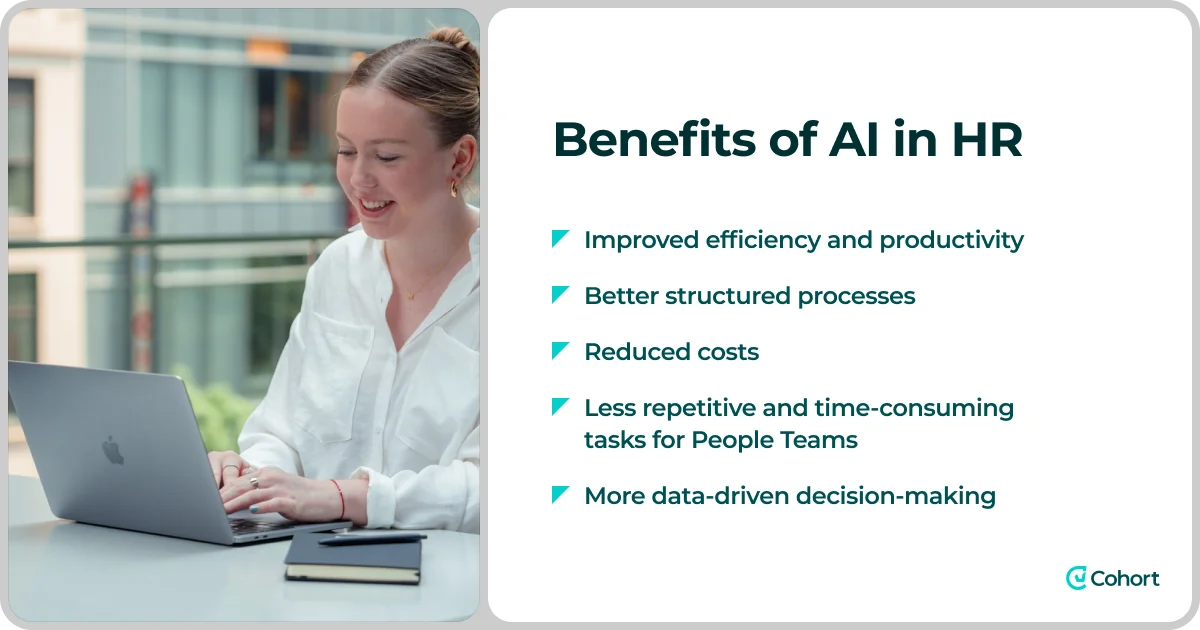
For example, a new employee can ask how to enroll in health insurance, and the chatbot will instantly provide the answer by pulling it from internal documents.
🔨 What this looks like in practice:
- AI chatbots guide new employees through onboarding, answering questions as they go.
- Custom training materials can be generated from company documents, policies, or guides.
- Interactive learning modules and quizzes are created from existing content, eliminating the need to start from scratch.
With GenAI, HR teams can deliver a personalized onboarding experience for every role by creating training schedules tailored to each job.
This helps new hires ramp up faster and feel supported from the start.
2. Tailored career development paths
GenAI is also helping companies create personalized development plans for every employee.
AI systems can analyze each person’s current skills and match them with future roles, recommending courses, stretch projects, or certifications to help them grow and develop.
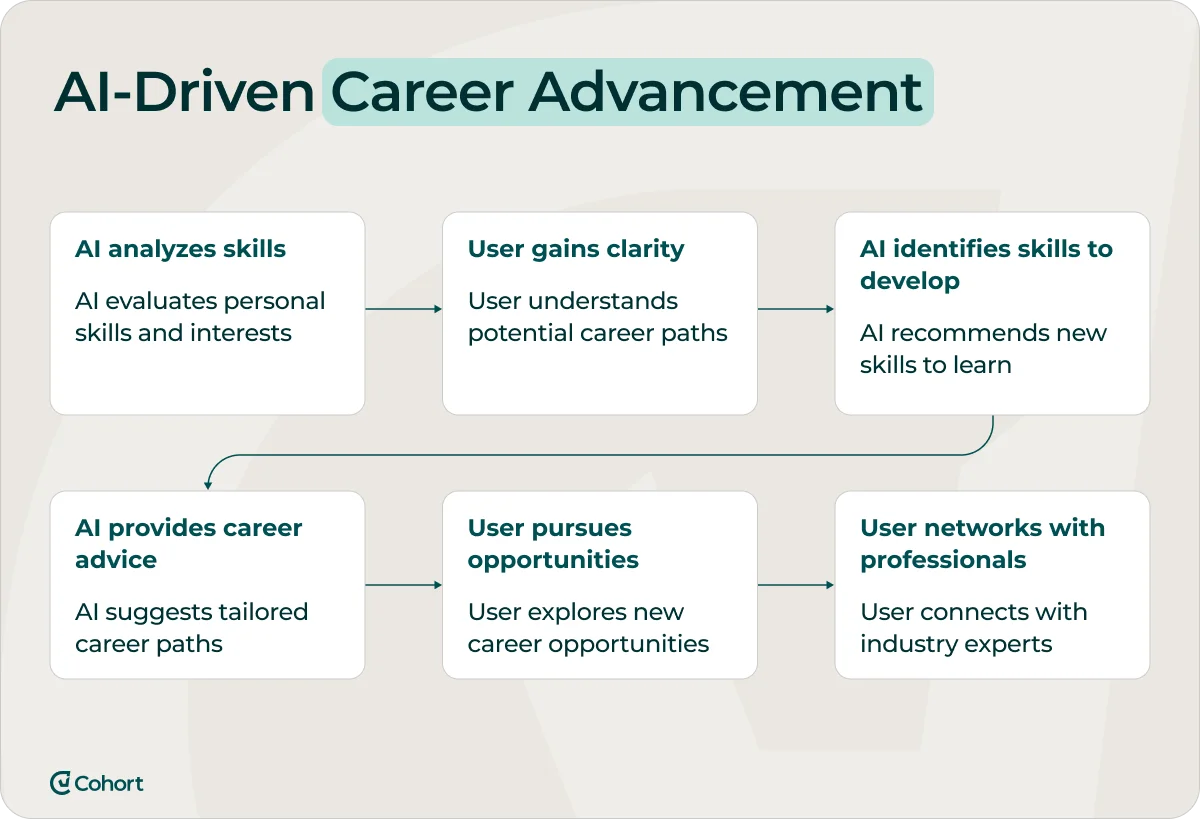
🚀 How this works:
- AI tools compare employee skills with job requirements to suggest growth opportunities.
- HR teams use these insights to create custom development plans.
- Managers receive AI-generated progress summaries to guide goal setting.
🧠 Example: An engineer might receive a suggested plan with a machine learning course and a temporary project in product management.
This kind of support builds trust and motivation, especially since 74% of employees say they’d stay longer at a company that offers personalized development opportunities.
3. Real-time feedback and engagement tools
GenAI also helps companies better understand and engage with employees.
Instead of waiting for yearly reviews, they can now use AI to track feedback in real-time using surveys, comments, chats, or forums.
🚀 Here’s what GenAI can do:
- Analyze large volumes of feedback to detect patterns or concerns (like rising stress or workload).
- Summarize open-ended responses into clear, useful insights for HR and managers.
- Automate feedback cycles by generating summaries after reviews or check-ins.
🧠 Example: If many employees raise workload concerns, AI can flag the issue and alert managers.
Some tools also prompt feedback or suggest team collaborations.
Studies show that AI-generated feedback can boost performance improvement rates by 40%, and 50% of employees say they trust AI to provide fair, unbiased input.
💡 Pro tip
Cohort’s Charlie the Closer keeps candidates engaged with automated follow-ups, Q&A, and post-interview check-ins.
It also handles reference checks and offer logistics to ensure a smooth, bias-aware close for every candidate.
This helps reduce drop-offs and fosters trust through consistent and timely communication.
How can HR teams use generative AI tools safely and fairly?
To make generative AI safe and fair in HR, companies need clear policies, regular bias checks, strong data privacy, and human oversight in key decisions.
Here's how organizations can build trust, ensure fairness, and stay ahead of the curve in terms of regulation:

1. Ensure fairness and minimize bias
When designed and used thoughtfully, GenAI can help reduce bias in hiring.
AI systems can identify patterns that humans may overlook, bringing greater consistency to decisions, such as resume screening and candidate evaluations.
📌 How to use AI to support fairness:
- Train models on diverse, representative datasets to reflect a broad range of talent.
- Use built-in bias detection tools and schedule regular fairness audits.
- Establish ethics guidelines and provide anti-bias training to HR and tech teams.
- Keep a human in the loop for decisions related to hiring, promotions, or pay.
✅ Fun fact: Two-thirds of hiring managers believe AI will be able to remove or mitigate cultural biases from the interview process.
2. Protect data and respect privacy
Most GenAI systems require large datasets to function well, which makes data protection a top priority.
Whether training an AI model or feeding it employee records, sensitive information must be handled with care.
📌 Best practices include:
- Limit data collection to only what’s necessary.
- Utilize techniques such as anonymization or differential privacy to remove personal identifiers.
- Clearly explain to employees how their data is used and stored.
- Stay compliant with laws like GDPR, CCPA, and EEOC guidance on AI in hiring.
⚠️ Important to know: The global average cost of a data breach reached $4.9 million in 2024, a 10% increase from the previous year and the highest recorded to date.
This highlights the importance of strong AI risk management, audits, and training in protecting data and fostering trust.
💡 Pro tip
Cohort AI protects data by setting strict retention limits, securely deleting inactive candidate records, and adhering to regional privacy laws such as GDPR and CCPA.
It also uses approved safeguards for international data transfers to ensure your information stays protected wherever it’s processed.
3. Build governance and stay ready for regulation
Despite growing adoption, many companies still lack formal AI policies even as legal risks and ethical concerns continue to rise.
States like New York and Colorado have already passed AI-specific laws, and broader regulations such as the EU AI Act are on the horizon.
📌 Steps to take:
- Develop a clear internal AI policy that outlines how AI tools can be effectively utilized across various HR functions.
- Use AI platforms with built-in privacy controls and audit logs to align with data protection laws and reduce compliance risk.
- Monitor new laws and frameworks, such as NIST’s AI Risk Management Framework, to inform policy updates and ensure readiness.
❗ Important to remember: Strong AI governance builds trust and helps your organization stay resilient as rules and technologies change.
Why is Cohort one of the best AI hiring tools in 2025?
Cohort AI brings generative AI into real-world HR workflows, from sourcing to engagement, so teams can hire faster, communicate better, and scale without adding headcount.
Its specialized agents automate key tasks while keeping everything structured, personalized, and easy to manage.
Here’s how Cohort is putting GenAI to work across the talent lifecycle:
- More innovative sourcing: Sally the Scout finds high-signal candidates based on skills and public work, so you skip resume scrolling.
- Efficient assessments: Eva the Evaluator runs async, role-specific interviews and scores responses based on your chosen success signals.
- Personalized outreach: Pete the Prospector creates tailored messages using generative content trained on your brand and job needs.
- Stronger engagement: Charlie the Closer automates follow-ups and Q&A to build trust and prevent drop-offs.
- Smarter matching: The Talent Graph links skills, behavior, and fit to match how candidates work, not just where they’ve worked.
- Decision-ready shortlists: Get your top three screened candidates in days so teams can move straight to hiring.
Book a free demo today to discover how Cohort AI revolutionizes HR with generative AI that enhances speed, accuracy, and impact.



